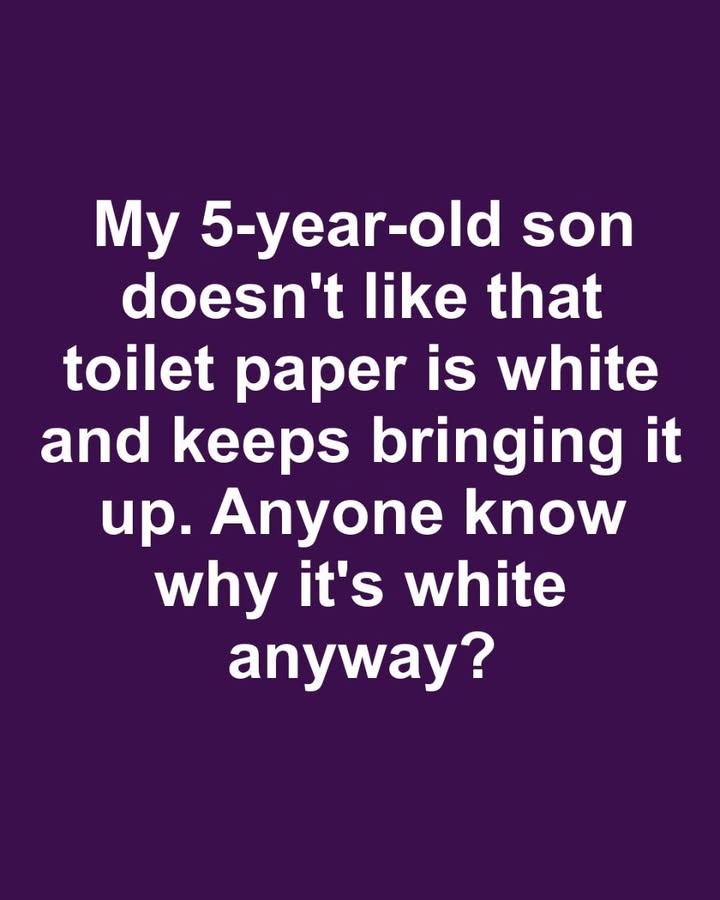Who would’ve thought a trip to the bathroom with my five-year-old would lead to one of the most unexpectedly enlightening conversations I’ve had in a while? It started innocently enough—he looked up from washing his hands and asked, “Why is toilet paper always white?” A simple question, right?

But the moment he said it, my brain stalled. I realized I had absolutely no idea. And so began an unplanned deep dive into the history, science, psychology, and even marketing behind the everyday roll of toilet paper. What I discovered was far more interesting than I ever expected. Kids have this amazing ability to notice the details adults take for granted. In a world filled with brightly colored toys, books, and cartoon characters, a roll of plain white tissue paper suddenly seemed unusually boring to him. What he saw as strange, I had always accepted as normal without questioning. That’s the beauty of a child’s curiosity—it pushes us to think beyond the obvious. As I dug into the topic, I discovered that toilet paper wasn’t always white.
Back in the mid-1900s, it actually came in a variety of pastel colors—pink, blue, green, even peach—and some brands even coordinated the paper with common bathroom décor trends. You could match your tissue to your tiles or towels. It wasn’t just about function; it was about fashion. But over time, things shifted. White began to symbolize cleanliness and purity. Consumers started to associate white toilet paper with hygiene and safety, while colorful paper raised questions, even subconsciously, about whether it was clean or safe for sensitive skin. Add in the rising costs and environmental concerns of using dyes, and it made sense why manufacturers began moving toward a universal standard of white.
The process behind making toilet paper also plays a huge role in its color. It starts with wood pulp, which naturally has a brownish hue. During production, the pulp is broken down and then bleached—not just to whiten it, but to remove impurities and lignin, which holds the wood fibers together. This bleaching step makes the paper softer, more absorbent, and more suitable for its intended use. So the white color isn’t just aesthetic—it’s a byproduct of a process meant to improve performance. Then there’s the psychological aspect of it. White has long been tied to ideas of sterility, safety, and cleanliness. It’s the reason hospitals use white sheets, doctors wear white coats, and cleaning products are often packaged in white containers.
When you see a white product in the bathroom, your brain feels reassured that it’s fresh and sanitary. Colored paper, on the other hand, can make people question whether it’s as pure or safe, especially when it comes to personal hygiene. From a business perspective, sticking to white also makes economic and environmental sense. Creating different colors of toilet paper would require separate dye batches, specialized packaging, and more energy and materials in production. That means higher costs and more waste. By standardizing the product, companies reduce complexity, save money, and streamline their supply chains. Even the bleaching process today has become more eco-friendly, with many brands using recycled fibers and less harmful chemicals. Ironically, that white roll may be greener than its colorful ancestors. If you’re wondering whether colored or patterned toilet paper still exists, the answer is yes—but it’s rare and mostly offered by boutique brands or novelty retailers. They come in fun shades or with floral prints, but they’re more expensive, often include fragrances or dyes, and may not be great for people with sensitive skin. Which is probably why most people continue to reach for that familiar, white option on the store shelf. Reflecting on all this, I realized that my son’s simple question opened the door to a much bigger conversation about the things we use every day without thinking twice. He reminded me that curiosity isn’t just for science class or trivia night—it can be found in the most mundane, overlooked objects in our lives. That roll of toilet paper hanging beside the sink? It’s a story of evolving consumer habits, industrial design, color psychology, and environmental considerations. And when we pause long enough to look at these things through a child’s eyes, we’re often reminded how much wonder really exists in the ordinary. So the next time your child—or anyone—asks you a question that seems silly or too basic to answer, lean in. Start digging. Follow the trail. You might find yourself learning more than you expected, even from something as everyday as a roll of tissue. Because sometimes, the most profound answers come from the simplest questions—and those questions have the power to reconnect us with curiosity, conversation, and the joy of discovering something new.





